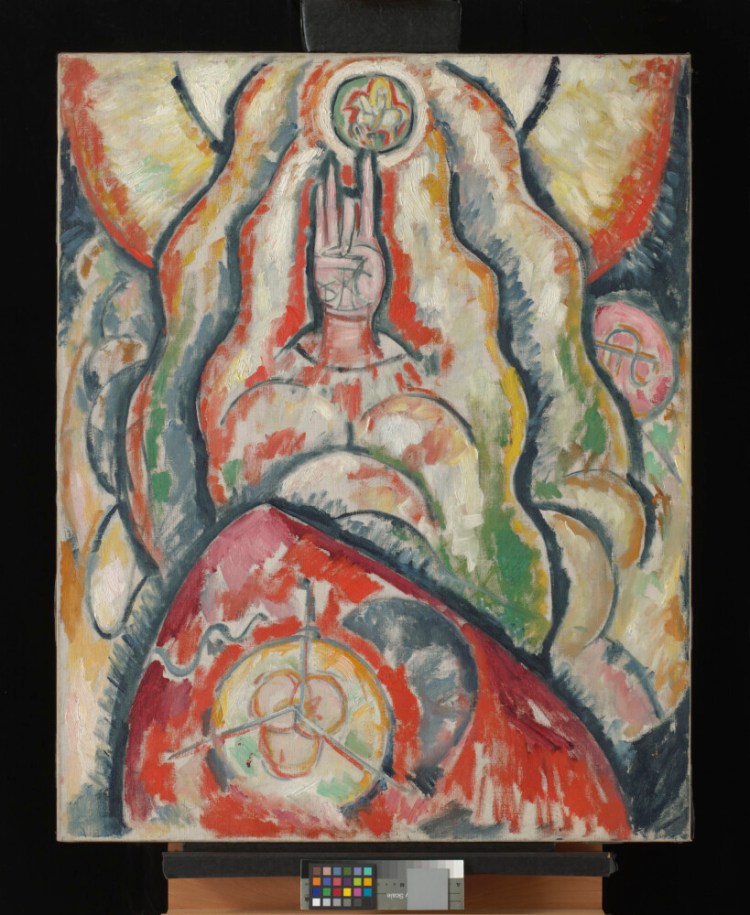LEWISTON — Dan Mills, director of the Bates College Museum of Art, isn’t shy in his opinion about “Marsden Hartley: Adventurer in the Arts,” on view for just one more week at his museum.
“This is an astounding exhibition. These are masterworks,” said Mills, who directed his words of praise at colleagues William Low, the museum’s curator and Hartley specialist, and Emily Schuchardt Navratil, curator of the New York-based Vilcek Foundation, which collaborated with the museum on the exhibition. “We have this wonderful partnership with the foundation. While we have drawings that span Hartley’s entire career and objects and ephemera that he collected throughout his life and travels, the Vilcek Foundation has a select number of largely masterworks that span his entire artistic output, so the complement is really great.”
The exhibition closes Nov. 18. It has drawn a steady stream of visitors since the Bates campus reopened to the public in early October. “Adventurer in the Arts” includes more than 35 paintings and drawings spanning 36 years of Hartley’s career, focusing on Hartley’s itinerant-artist lifestyle with examples of his work from around the world – from western Maine to New Mexico, New York to Berlin, and places in between and beyond.
Hartley traveled the world while always calling Maine home. He was born in Lewiston in 1877 and died in Ellsworth in 1943, and spent most of the years in between on the move as he became a titan of modernist art. Bates owns the Marsden Hartley Memorial Collection of more than 100 drawings, paintings and other possessions. It includes things like his palette, pens and brushes, as well his travel bags, luggage tags and postcards from his journeys. At the same time, the museum has undertaken the ambitious Marsden Hartley Legacy Project in collaboration with Portland-based art historian and Hartley scholar Gail R. Scott, which involves creating a comprehensive, annotated online catalog of all known paintings and works on paper that Hartley created.
Those efforts, along with collaborative exhibitions such as this one, which includes a scholarly catalog detailing the artist’s travels and the paintings and drawings he made along the way, help establish the Bates Museum as a repository for Hartley work and a center for research, Mills said.

The oil painting “Schiff” by Marsden Hartley is the centerpiece of a soon-to-close exhibition at the Bates College Museum of Art. Hartley made the painting in Germany in spring 1915, and it references Native American and German cultures. Courtesy of Vilcek Collection, New York, and Bates College Museum of Art
The centerpiece of “Adventurer in the Arts” is the painting “Schiff,” which Hartley painted in 1915 in Germany. “Schiff” is the German word for ship, or boat, and this piece includes an image of a canoe and abstracted references to Indigenous and German cultures, perhaps bridging Hartley’s world in Maine and his world abroad. It’s the first time the painting has been shown in the United States.
It was inspired by Hartley’s travels, Mills said. Hartley had been in Paris in 1912 and traveled to Germany a year later, where he developed romantic feelings for an officer in the German army, who later died in war. He returned to Germany regularly over the next 20 years, and it became among an important place in his artistic and personal life.
Coincidentally, the Farnsworth Art Museum in Rockland is showing the print series “Robert Indiana: The Hartley Elegies” through Jan. 2. Indiana, who admired Hartley and was inspired by his life and art, made a series of paintings and prints as an homage to Hartley, based on a painting Hartley made about the fallen German officer at about the same time he painted “Schiff.”
Mills saw “Schiff” at a Hartley exhibition at the Louisiana Museum of Modern Art in Denmark in 2019, before the pandemic. Soon after, Navratil visited Bates to become familiar with the Hartley collection of artwork, snapshots and keepsakes.
“After Emily left, she proposed this exhibition. She recognized there was not only this trove of work that we have, but there was an opportunity for a scholarly slant by looking at place and the importance of place in Hartley’s life and art by pairing their paintings with our drawings and other items,” he said.
The catalog includes more than 200 illustrations and reproductions, along with essays by Low, Navratil and Vilcek Foundation Director Rick Kinsel, as well as a preface by Mills.
Send questions/comments to the editors.



